Chapter: Security in Computing : Designing Trusted Operating Systems
Evaluation
Evaluation
Most system consumers (that
is, users or system purchasers) are not security experts. They need the
security functions, but they are not usually capable of verifying the accuracy
or adequacy of test coverage, checking the validity of a proof of correctness,
or determining in any other way that a system correctly implements a security
policy. Thus, it is useful (and sometimes essential) to have an independent third
party evaluate an operating system's security. Independent experts can review
the requirements, design, implementation, and evidence of assurance for a
system. Because it is helpful to have a standard approach for an evaluation,
several schemes have been devised for structuring an independent review. In
this section, we examine three different approaches: from the United States,
from Europe, and a scheme that combines several known approaches.
U.S. "Orange Book" Evaluation
In the late 1970s, the U.S.
Department of Defense (DoD) defined a set of distinct, hierarchical levels of
trust in operating systems. Published in a document [DOD85]
that has become known informally as the "Orange Book," the Trusted
Computer System Evaluation Criteria (TCSEC) provides the criteria for an
independent evaluation. The National Computer Security Center (NCSC), an
organization within the National Security Agency, guided and sanctioned the
actual evaluations.
The levels of trust are described as four
divisions, A, B, C, and D, where A has the most comprehensive degree of
security. Within a division, additional distinctions are denoted with numbers;
the higher numbers indicate tighter security requirements. Thus, the complete
set of ratings ranging from lowest to highest assurance is D, C1, C2, B1, B2,
B3, and A1. Table 5 -7 (from Appendix D
of [DOD85]) shows the security
requirements for each of the seven evaluated classes of NCSC certification.
(Class D has no requirements because it denotes minimal protection.)
D, with no requirements
C1/C2/B1, requiring security
features common to many commercial operating systems
B2, requiring a precise proof
of security of the underlying model and a narrative specification of the
trusted computing base
B3/A1, requiring more
precisely proven descriptive and formal designs of the trusted computing base
These clusters do not imply
that classes C1, C2, and B1 are equivalent. However, there are substantial
increases of stringency between B1 and B2, and between B2 and B3 (especially in
the assurance area). To see why, consider the requirements for C1, C2, and B1.
An operating system developer might be able to add security measures to an
existing operating system in order to qualify for these ratings. However, security
must be included in the design of the operating system for a B2 rating.
Furthermore, the design of a B3 or A1 system must begin with construction and
proof of a formal model of security. Thus, the distinctions between B1 and B2
and between B2 and B3 are significant.
Let us look at each class of
security described in the TCSEC. In our descriptions, terms in quotation marks
have been taken directly from the Orange Book to convey the spirit of the
evaluation criteria.
Class D: Minimal Protection
This class is applied to
systems that have been evaluated for a higher category but have failed the
evaluation. No security characteristics are needed for a D rating.
Class C1: Discretionary Security Protection
C1 is intended for an
environment of cooperating users processing data at the same level of
sensitivity. A system evaluated as C1 separates users from data. Controls must
seemingly be sufficient to implement access limitation, to allow users to
protect their own data. The controls of a C1 system may not have been
stringently evaluated; the evaluation may be based more on the presence of
certain features. To qualify for a C1 rating, a system must have a domain that
includes security functions and that is protected against tampering. A keyword
in the classification is "discretionary." A user is
"allowed" to decide when the controls apply, when they do not, and
which named individuals or groups are allowed access.
Class C2: Controlled Access Protection
A C2 system still implements
discretionary access control, although the granularity of control is finer. The
audit trail must be capable of tracking each individual's access (or attempted
access) to each object.
Class B1: Labeled Security Protection
All certifications in the B
division include nondiscretionary access control. At the B1 level, each
controlled subject and object must be assigned a security level. (For class B1,
the protection system does not need to control every object.)
Each controlled object must
be individually labeled for security level, and these labels must be used as
the basis for access control decisions. The access control must be based on a
model employing both hierarchical levels and nonhierarchical categories. (The
military model is an example of a system with hierarchical levelsunclassified,
classified, secret, top secretand nonhierarchical categories, need-to-know
category sets.) The mandatory access policy is the BellLa Padula model. Thus, a
B1 system must implement BellLa Padula controls for all accesses, with user
discretionary access controls to further limit access.
Class B2: Structured Protection
The major enhancement for B2
is a design requirement: The design and implementation of a B2 system must
enable a more thorough testing and review. A verifiable top-level design must be
presented, and testing must confirm that the system implements this design. The
system must be internally structured into "well-defined largely
independent modules." The principle of least privilege is to be enforced
in the design. Access control policies must be enforced on all objects and
subjects, including devices. Analysis of covert channels is required.
Class B3: Security Domains
The security functions of a B3 system must be
small enough for extensive testing. A high-level design must be complete and
conceptually simple, and a "convincing argument" must exist that the
system implements this design. The implementation of the design must
"incorporate significant use of layering, abstraction, and information
hiding."
The security functions must
be tamperproof. Furthermore, the system must be "highly resistant to
penetration." There is also a requirement that the system audit facility
be able to identify when a violation of security is imminent.
Class A1: Verified Design
Class A1 requires a formally verified
system design. The capabilities of the system are the same as for class B3. But
in addition there are five important criteria for class A1 certification: (1) a
formal model of the protection system and a proof of its consistency and
adequacy,
(2) a formal top-level
specification of the protection system, (3) a demonstration that the top-level
specification corresponds to the model,
(4) an implementation
"informally" shown to be consistent with the specification, and (5)
formal analysis of covert channels.
European ITSEC Evaluation
The TCSEC was developed in
the United States, but representatives from several European countries also
recognized the need for criteria and a methodology for evaluating
security-enforcing products. The European efforts culminated in the ITSEC, the
Information Technology Security Evaluation Criteria [ITS91b].
Origins of the ITSEC
England, Germany, and France
independently began work on evaluation criteria at approximately the same time.
Both England and Germany published their first drafts in 1989; France had its
criteria in limited review when these three nations, joined by the Netherlands,
decided to work together to develop a common criteria document. We examine
Britain and Germany's efforts separately, followed by their combined output.
German Green Book
The (then West) German
Information Security Agency (GISA) produced a catalog of criteria [GIS88] five years after the first use of the
U.S. TCSEC. Keeping with tradition, the security community began to call the
document the German Green Book because of its green cover. The German criteria
identified eight basic security functions, deemed sufficient to enforce a broad
spectrum of security policies:
identification and
authentication: unique and certain association of an identity with a subject or
object
administration of rights: the
ability to control the assignment and revocation of access rights between
subjects and objects
verification of rights:
mediation of the attempt of a subject to exercise rights with respect to an
object
audit: a record of
information on the successful or attempted unsuccessful exercise of rights
object reuse: reusable
resources reset in such a way that no information flow occurs in contradiction
to the security policy
error recovery: identification
of situations from which recovery is necessary and invocation of an appropriate
action
continuity of service:
identification of functionality that must be available in the system and what
degree of delay or loss (if any) can be tolerated
data communication security:
peer entity authentication, control of access to communications resources, data
confidentiality, data integrity, data origin authentication, and nonrepudiation
Note that the first five of
these eight functions closely resemble the U.S. TCSEC, but the last three move
into entirely new areas: integrity of data, availability, and a range of
communications concerns.
Like the U.S. DoD, GISA did
not expect ordinary users (that is, those who were not security experts) to
select appropriate sets of security functions, so ten functional classes were
defined. Classes F1 through F5 corresponded closely to the functionality
requirements of U.S. classes C1 through B3. (Recall that the functionality
requirements of class A1 are identical to those of B3.) Class F6 was for high
data and program integrity requirements, class F7 was appropriate for high
availability, and classes F8 through F10 relate to data communications
situations. The German method addressed assurance by defining eight quality levels,
Q0 through Q7, corresponding roughly to the assurance requirements of U.S.
TCSEC levels D through A1, respectively. For example,
The evaluation of a Q1 system is merely
intended to ensure that the implementation more or less enforces the security
policy and that no major errors exist.
The goal of a Q3 evaluation
is to show that the system is largely resistant to simple penetration attempts.
To achieve assurance level
Q6, it must be formally proven that the highest specification level meets all
the requirements of the formal security policy model. In addition, the source
code is analyzed precisely.
These functionality classes and assurance
levels can be combined in any way, producing potentially 80 different
evaluation results, as shown in Table 5-8.
The region in the upper-right portion of the table represents requirements in
excess of U.S. TCSEC requirements, showing higher assurance requirements for a
given functionality class. Even though assurance and functionality can be
combined in any way, there may be limited applicability for a low -assurance,
multilevel system (for example, F5, Q1) in usage. The Germans did not assert
that all possibilities would necessarily be useful, however.
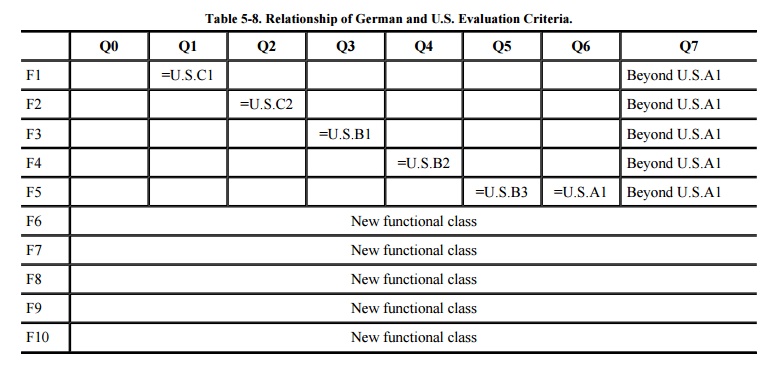
Another significant
contribution of the German approach was to support evaluations by independent,
commercial evaluation facilities.
British Criteria
The British criteria
development was a joint activity between the U.K. Department of Trade and
Industry (DTI) and the Ministry of Defence (MoD). The first public version,
published in 1989 [DTI89a], was issued
in several volumes.
The original U.K. criteria
were based on the "claims" language, a metalanguage by which a vendor
could make claims about functionality in a product. The claims language
consisted of lists of action phrases
and target phrases with parameters.
For example, a typical action phrase might look like this:
This
product can [not] determine … [using the mechanism described in paragraph n of
this document] …
The parameters product and n
are, obviously, replaced with specific references to the product to be
evaluated. An example of a target phrase is
… the
access-type granted to a [user, process] in respect of a(n) object.
These two phrases can be
combined and parameters replaced to produce a claim about a product.
This
access control subsystem can determine the read access granted to all subjects
in respect to system files.
The claims language was
intended to provide an open -ended structure by which a vendor could assert
qualities of a product and independent evaluators could verify the truth of
those claims. Because of the generality of the claims language, there was no
direct correlation of U.K. and U.S. evaluation levels.
In addition to the claims language, there were
six levels of assurance evaluation, numbered L1 through L6, corresponding
roughly to U.S. assurance C1 through A1 or German Q1 through Q6.
The claims language was
intentionally open-ended because the British felt it was impossible to predict
which functionality manufacturers would choose to put in their products. In
this regard, the British differed from Germany and the United States, who
thought manufacturers needed to be guided to include specific functions with
precise functionality requirements. The British envisioned certain popular
groups of claims being combined into bundles that could be reused by many
manufacturers.
The British defined and
documented a scheme for Commercial Licensed Evaluation Facilities (CLEFs) [DTI89b], with precise requirements for the
conduct and process of evaluation by independent commercial organizations.
Other Activities
As if these two efforts were
not enough, Canada, Australia, and France were also working on evaluation
criteria. The similarities among these efforts were far greater than their
differences. It was as if each profited by building upon the predecessors'
successes.
Three difficulties, which
were really different aspects of the same problem, became immediately apparent.
Comparability. It was not
clear how the different evaluation criteria related. A German F2/E2 evaluation
was structurally quite similar to a U.S. C2 evaluation, but an F4/E7 or F6/E3
evaluation had no direct U.S. counterpart. It was not obvious which U.K. claims
would correspond to a particular U.S. evaluation level.
Transferability. Would a
vendor get credit for a German F2/E2 evaluation in a context requiring a U.S.
C2? Would the stronger F2/E3 or F3/E2 be accepted?
Marketability. Could a vendor
be expected to have a product evaluated independently in the United States,
Germany, Britain, Canada, and Australia? How many evaluations would a vendor
support? (Many vendors suggested that they would be interested in at most one
because the evaluations were costly and time consuming.)
For reasons including these
problems, Britain, Germany, France, and the Netherlands decided to pool their
knowledge and synthesize their work.
ITSEC: Information Technology Security Evaluation Criteria
In 1991 the Commission of the
European Communities sponsored the work of these four nations to produce a
harmonized version for use by all European Union member nations. The result was
a good amalgamation.
The ITSEC preserved the
German functionality classes F1F10, while allowing the flexibility of the
British claims language. There is similarly an effectiveness component to the evaluation, corresponding roughly to
the U.S. notion of assurance and to the German E0E7 effectiveness levels.
A vendor (or other
"sponsor" of an evaluation) has to define a target of evaluation (TOE), the item that is the evaluation's
focus. The TOE is considered in the context of an operational environment (that
is, an expected set of threats) and security enforcement requirements. An
evaluation can address either a product (in general distribution for use in a
variety of environments) or a system (designed and built for use in a specified
setting). The sponsor or vendor states the following information:
system security policy or
rationale: why this product (or system) was built
specification of security-enforcing functions: security
properties of the product (or system)
definition of the mechanisms of the product (or system) by
which security is enforced
a claim about the strength of the mechanisms
the target evaluation level in terms of
functionality and effectiveness
The evaluation proceeds to
determine the following aspects:
suitability of functionality: whether the chosen functions implement the
desired security features
binding of functionality: whether the chosen functions work together
synergistically
vulnerabilities: whether vulnerabilities exist either in the construction of the
TOE or how it will work in its intended environment
ease of use
strength of mechanism: the
ability of the TOE to withstand direct attack
The results of these
subjective evaluations determine whether the evaluators agree that the product
or system deserves its proposed functionality and effectiveness rating.
Significant Departures from the Orange Book
The European ITSEC offers the following significant
changes compared with the Orange Book. These variations have both advantages
and disadvantages, as listed in Table 5-9.
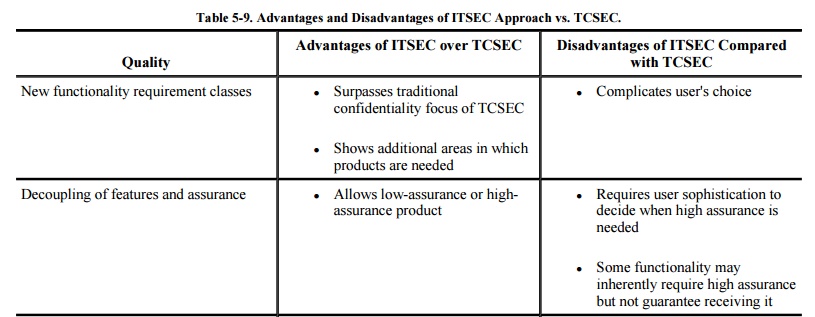
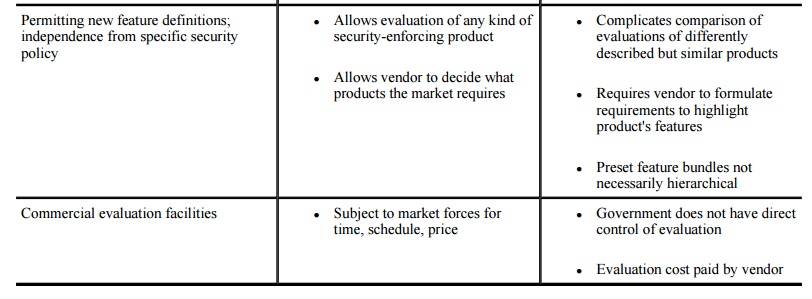
U.S. Combined Federal Criteria
In 1992, partly in response
to other international criteria efforts, the United States began a successor to
the TCSEC, which had been written over a decade earlier. This successor, the Combined Federal Criteria [NSA92], was produced jointly by the National
Institute for Standards and Technology (NIST) and the National Security Agency
(NSA) (which formerly handled criteria and evaluations through its National
Computer Security Center, the NCSC).
The team creating the Combined Federal Criteria
was strongly influenced by Canada's criteria [CSS93],
released in draft status just before the combined criteria effort began.
Although many of the issues addressed by other countries' criteria were the
same for the United States, there was a compatibility issue that did not affect
the Europeans, namely, the need to be fair to vendors that had already passed
U.S. evaluations at a particular level or that were planning for or in the
middle of evaluations. Within that context, the new U.S. evaluation model was
significantly different from the TCSEC. The combined criteria draft resembled
the European model, with some separation between features and assurance.
The Combined Federal Criteria introduced the
notions of security target (not to be confused with a target of evaluation, or
TOE) and protection profile. A user would generate a protection profile to detail the protection needs, both functional
and assurance, for a specific situation or a generic scenario. This user might
be a government sponsor, a commercial user, an organization representing many
similar users, a product vendor's marketing representative, or a product
inventor. The protection profile would be an abstract specification of the
security aspects needed in an information technology (IT) product. The
protection profile would contain the elements listed in Table 5-10.
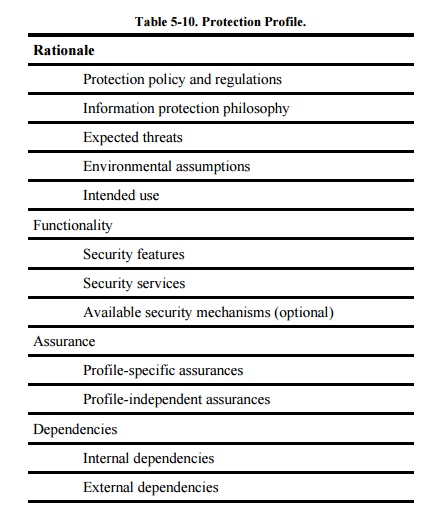
In response to a protection profile, a vendor
might produce a product that, the vendor would assert, met the requirements of
the profile. The vendor would then map the requirements of the protection
profile in the context of the specific product onto a statement called a security target. As shown in Table 5-11, the security target matches the
elements of the protection profile.
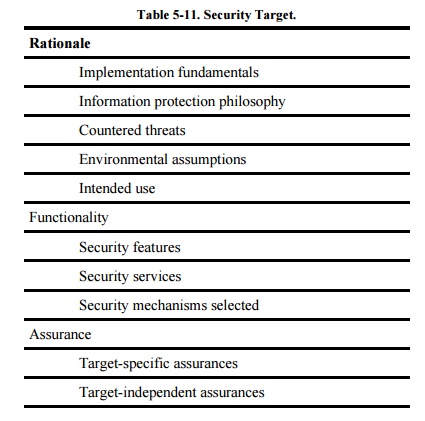

The security target then
becomes the basis for the evaluation. The target details which threats are
countered by which features, to what degree of assurance and using which
mechanisms. The security target outlines the convincing argument that the
product satisfies the requirements of the protection profile. Whereas the protection
profile is an abstract description of requirements, the security target is a
detailed specification of how each of those requirements is met in the specific
product.
The criteria document also
included long lists of potential requirements (a subset of which could be
selected for a particular protection profile), covering topics from object
reuse to accountability and from covert channel analysis to fault tolerance.
Much of the work in specifying precise requirement statements came from the
draft version of the Canadian criteria.
The U.S. Combined Federal
Criteria was issued only once, in initial draft form. After receiving a round
of comments, the editorial team announced that the United States had decided to
join forces with the Canadians and the editorial board from the ITSEC to
produce the Common Criteria for the
entire world.
Common Criteria
The Common Criteria [CCE94, CCE98]
approach closely resembles the U.S. Federal Criteria (which, of course, was
heavily influenced by the ITSEC and Canadian efforts). It preserves the
concepts of security targets and protections profiles. The U.S. Federal
Criteria were intended to have packages of protection requirements that were
complete and consistent for a particular type of application, such as a network
communications switch, a local area network, or a stand-alone operating system.
The example packages received special attention in the Common Criteria.
The Common Criteria defined topics of interest
to security, shown in Table 5-12. Under
each of these classes, they defined families of functions or assurance needs,
and from those families, they defined individual components, as shown in Figure 5-24.

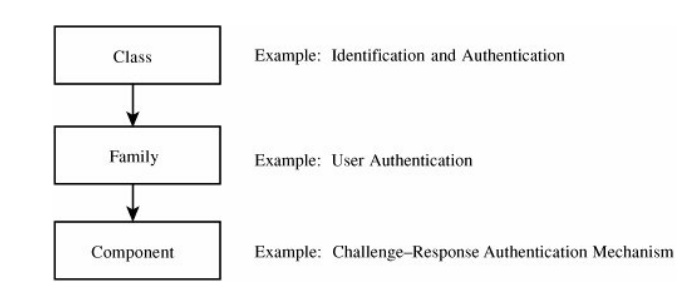
Individual components were then combined into
packages of components that met some comprehensive requirement (for
functionality) or some level of trust (for assurance), as shown in Figure 5-25.
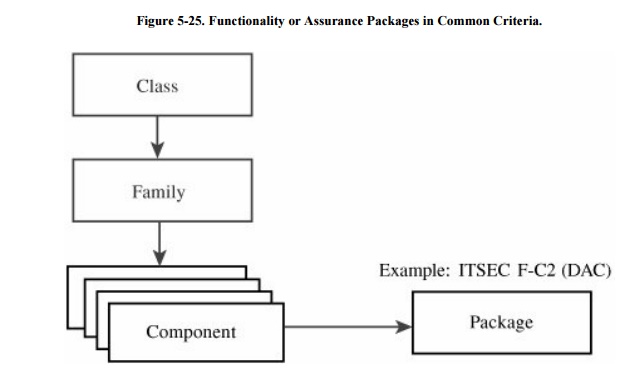

Summary of Evaluation Criteria
The criteria were intended to
provide independent security assessments in which we could have some
confidence. Have the criteria development efforts been successful? For some, it
is too soon to tell. For others, the answer lies in the number and kinds of
products that have passed evaluation and how well the products have been
accepted in the marketplace.
Evaluation Process
We can examine the evaluation
process itself, using our own set of objective criteria. For instance, it is
fair to say that there are several desirable qualities we would like to see in
an evaluation, including the following:
Extensibility. Can the evaluation be extended as the product is enhanced?
Granularity. Does the evaluation look at the product at the right level of
detail?
Speed. Can the evaluation be done quickly enough to allow the product to
compete in the marketplace?
Thoroughness. Does the evaluation look at all relevant aspects of the product?
Objectivity. Is the evaluation independent of the reviewer's opinions? That is,
will two different reviewers give the same rating to a product?
Portability. Does the evaluation apply to the product no matter what platform
the product runs on?
Consistency. Do similar
products receive similar ratings? Would one product evaluated by different
teams receive the same results?
Compatibility. Could a
product be evaluated similarly under different criteria? That is, does one
evaluation have aspects that are not examined in another?
Exportability. Could an
evaluation under one scheme be accepted as meeting all or certain requirements
of another scheme?
Using these characteristics,
we can see that the applicability and extensibility of the TCSEC are somewhat
limited. Compatibility is being addressed by combination of criteria, although
the experience with the ITSEC has shown that simply combining the words of
criteria documents does not necessarily produce a consistent understanding of
them. Consistency has been an important issue, too. It was unacceptable for a
vendor to receive different results after bringing the same product to two
different evaluation facilities or to one facility at two different times. For
this reason, the British criteria documents stressed consistency of evaluation
results; this characteristic was carried through to the ITSEC and its companion
evaluation methodology, the ITSEM. Even though speed, thoroughness, and
objectivity are considered to be three essential qualities, in reality
evaluations still take a long time relative to a commercial computer product
delivery cycle of 6 to 18 months.
Criteria Development Activities
Evaluation criteria continue
to be developed and refined. If you are interested in doing evaluations, in
buying an evaluated product, or in submitting a product for evaluation, you
should follow events closely in the evaluation community. You can use the
evaluation goals listed above to help you decide whether an evaluation is
appropriate and which kind of evaluation it should be.
It is instructive to look back at the evolution
of evaluation criteria documents, too. Figure 5-27
shows the timeline for different criteria publications; remember that the
writing preceded the publication by one or more years. The figure begins with
Anderson's original Security Technology Planning Study [AND72], calling for methodical, independent
evaluation. To see whether progress is being made, look at the dates when
different criteria documents were published; earlier documents influenced the
contents and philosophy of later ones.
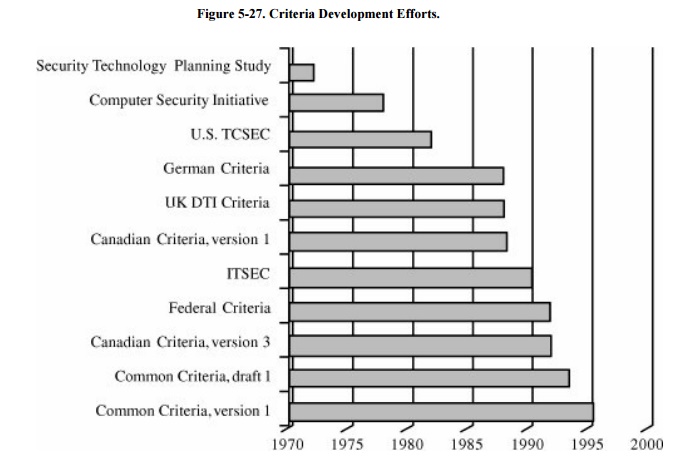
The criteria development
activities have made significant progress since 1983. The U.S. TCSEC was based
on the state of best practice known around 1980. For this reason, it draws
heavily from the structured programming paradigm that was popular throughout
the 1970s. Its major difficulty was its prescriptive manner; it forced its
model on all developments and all types of products. The TCSEC applied most
naturally to monolithic, stand-alone, multiuser operating systems, not to the
heterogeneous, distributed, networked environment based largely on individual
intelligent workstations that followed in the next decade.
Experience with Evaluation Criteria
To date, criteria efforts
have been paid attention to by the military, but those efforts have not led to
much commercial acceptance of trusted products. The computer security research
community is heavily dominated by defense needs because much of the funding for
security research is derived from defense departments. Ware [WAR95] points out the following about the
initial TCSEC:
It was driven by the U.S.
Department of Defense.
It focused on threat as
perceived by the U.S. Department of Defense.
It was based on a U.S.
Department of Defense concept of operations, including cleared personnel,
strong respect for authority and management, and generally secure physical
environments.
It had little relevance to
networks, LANs, WANs, Internets, client-server distributed architectures, and
other more recent modes of computing.
When the TCSEC was
introduced, there was an implicit contract between the U.S. government and
vendors, saying that if vendors built products and had them evaluated, the
government would buy them. Anderson [AND82]
warned how important it was for the government to keep its end of this bargain.
The vendors did their part by building numerous products: KSOS, PSOS, Scomp,
KVM, and Multics. But unfortunately, the products are now only of historical
interest because the U.S. government did not follow through and create the
market that would encourage those vendors to continue and other vendors to
join. Had many evaluated products been on the market, support and usability
would have been more adequately addressed, and the chance for commercial
adoption would have been good. Without government support or perceived
commercial need, almost no commercial acceptance of any of these products has
occurred, even though they have been developed to some of the highest quality
standards.
Schaefer [SCH04a] gives a thorough description of the
development and use of the TCSEC. In his paper he explains how the higher
evaluation classes became virtually unreachable for several reasons, and thus
the world has been left with less trustworthy systems than before the start of
the evaluation process. The TCSEC's almost exclusive focus on confidentiality
would have permitted serious integrity failures (as obliquely described in [SCH89b]).
On the other hand, some major
vendors are actively embracing low and moderate assurance evaluations: As of
May 2006, there are 78 products at EAL2, 22 at EAL3, 36 at EAL4, 2 at EAL5 and
1 at EAL7. Product types include operating systems, firewalls, antivirus software, printers, and
intrusion detection products. (The current list of completed evaluations
(worldwide) is maintained at www.commoncriteriaportal.org.) Some vendors have announced corporate commitments to
evaluation, noting that independent evaluation is a mark of quality that will always be a stronger selling
point than so-called emphatic assertion
(when a vendor makes loud claims about the strength of a product, with no
independent evidence to substantiate those claims). Current efforts in
criteria-writing support objectives, such as integrity and availability, as
strongly as confidentiality. This approach can allow a vendor to identify a
market niche and build a product for it, rather than building a product for a paper
need (that is, the dictates of the evaluation criteria) not matched by
purchases. Thus, there is reason for optimism regarding criteria and
evaluations. But realism requires everyone to accept that the marketnot a
criteria documentwill dictate what is desired and delivered. As Sidebar 5 -7 describes,
secure systems are sometimes seen as a marketing niche: not part of the
mainstream product line, and that can only be bad for security.
It is generally believed that the market will
eventually choose quality products. The evaluation principles described above
were derived over time; empirical evidence shows us that they can produce
high-quality, reliable products deserving our confidence. Thus, evaluation
criteria and related efforts have not been in vain, especially as we see
dramatic increases in security threats and the corresponding increased need for
trusted products. However, it is often easier and cheaper for product
proponents to speak loudly than to present clear evidence of trust. We caution
you to look for solid support for the trust you seek, whether that support be
in test and review results, evaluation ratings, or specialized assessment.
Related Topics